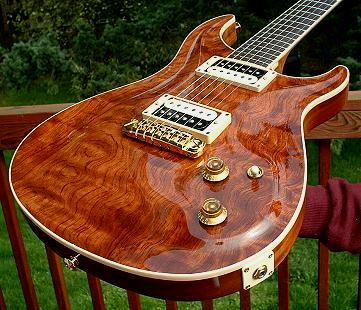Some species of wood we use to build projects are very understated. Subdued. Reserved.
And then there is Bubinga.
This exceptionally beautiful, hard and dense wood from central Africa is a true standout when it comes to furniture making. Known occasionally as African Rosewood, bubinga is one of 16 different species of the genus Guibourtia. The evergreen trees can reach heights of 40 – 50 meters tall with a trunk diameter of 1 – 2 meters.
Bubinga is a very tough wood. “It’s right up there on the Janka scale of hardness – taking nearly 2000 pounds of force to drive a steel ball halfway into a piece,” said Eric Poirier of Bell Forest Products. “That makes it a very good choice for all sorts of applications – especially for making tool handles and hand planes.”

Eric had helped me select an outstanding piece of bubinga when I had built my Krenov-style plane. The wood cut, planed and worked beautifully while still being impervious to the fingernail test.
Bubinga’s color is very unique and runs from a striking deep rose color toward a shade of red mixed with purple. While working with it, I kept remembering the distinctive label color found on a Dr. Pepper bottle. “This dramatic color really makes bubinga pop when paired as an accent with lighter wood. A maple project with bubinga accents… wow… now you are talking!”
“It’s not just the color, but the figure of the bubinga that can really be dramatic,” said Eric. “You can see burl, quilted or even something that closely resembled tiger striping within the highly figured boards.”
The wood is very durable, and is often used in boatbuilding. Turners absolutely love the stuff because it takes very crisp detailing. “A bubinga bowl really makes a statement, and bubinga pens will attract a lot of attention from admirers.”

Bell Forest Products keeps a supply of milled bubinga lumber on hand for projects. They also get some very choice boards that can be custom picked from pictures on their website. “Right now, we have an unbelievable kiln-dried slab of bubinga in stock. It’s 1 5/8” thick, 48” wide and a whopping 182” long. It’s got sweet live edges on both sides, and would allow a talented woodworker to make an outstanding project. Heck,” Eric continued, “we’re even throwing in the shipping for free!”


Tom – I built a dining room table from African Rosewood a couple of years ago (for myself!) I ran across this “bubinga is known as african rosewood” and checked with the hardwood supplier I bought the rosewood from, since they list both African Rosewood and Bubinga (at different prices!). Here’s their response:
The two species are often confused ..
Bubinga …Guibourtia Demeusi comes from central / West Africa
African Rosewood …. Guibourtia Coleosperma …from more south….Zambia mostly
Many people, including wood dealers, call Bubinga African Rosewood , which is not strictly incorrect, but does lead to confusion.
A ha! Commonly known… and commonly confused! 🙂
Hello Tom
Absolutely Beautiful
what a guitar, bravo!
I built a custom guitar amp from a 16′ timber of bubinga and I am sold,
not only is this wood beautiful beyond belief, but the tone quality is superb.
I highly Recommend it for Musical instruments.
Will Cascio
Owner/Builder Heavy Magic’s Soullfilled Sound Machines
Where did you get this or make this? I want that kind of wood on a guitar on both sides but not exacly that body, but otherwise. Please tell me 🙂
Thank you.
Many moons ago ( around 1976-77) the wholesale millwork company I worked for back then acquired a piece of African Mahogany that was 3″ thick, 54″ wide and just shy of 16′ long. They cut off 12′ and straight lined it to 48″ width, to use for a conference table and the owner used the balance ( roughly 3′ 10″ x 53 54″) for a table in his house. I had never seen a solid piece of wood that size, ever. Really impressive and beautiful when it was finished.